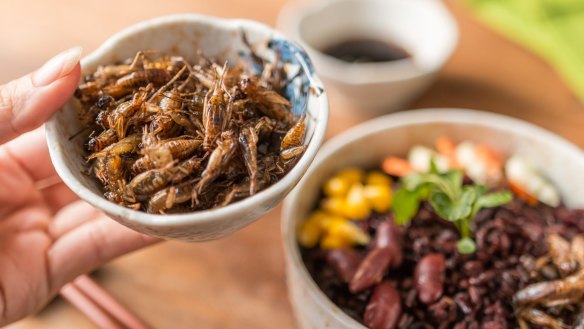Growing popularity of eating insects a potential bugbear on the environment

Insects are on track to becoming a staple in diets, but without proper planning the mass-raising of bugs could result in the same environmental issues caused by factory farming, new research suggests.
While remaining optimistic that suppliers "will rise to the challenge", the multi-million-dollar insects-as-food industry is forging ahead despite an "overwhelming lack of knowledge", Swedish researchers said in a Trends in Ecology & Evolution journal.
"Though the industry is in its infancy, some companies are getting bigger, and doing well, and the risks will come along with that," conservation biologist Asa Berggren said in the article.
Ms Berggren also describes the potential of an introduced insect escaping into a new ecosystem as "climate catastrophe".
Edible insects in Australia come in all shapes and sizes, from trendy eateries offering roasted spicy crickets, to retail stores packaging up lemon myrtle mealworms and ant seasoning.
And while the consumption of insects in Australia is steadily growing, Insect Protein Association of Australia's chair Olympia Yarger says it is still an emerging industry with farmers and retail sellers each producing roughly 200 kilograms of insects monthly.
Any new food industry hitting the market will inevitably throw up challenges, but Ms Yarger is positive Australian producers involved in the business are doing so in the most sustainable way.
"For edible insects clients tend to care about the impacts the food they eat has on the environment, so it makes sense that ethos is being carried through to the insect farmers and producers business model," Ms Yarger told AAP.
Ms Yarger believes the negative environmental impacts of mass-rearing insects which include the creation of artificial climates, biosecurity challenges and the potential for new pathogens, are far outweighed by the positive benefits.
Insects need significantly less non-arable land to grow and emit smaller quantities of greenhouse gases compared with livestock.
Regional bug farmers can also source feed locally rather than requiring trucks to cross vast distances.
"Farmers are now seeing the opportunity insects provide during a drought," Ms Yarger said.
"Especially when insects require a litre of water or less per kilo of protein, against cattle which requires 32 litres per kilo."
AAP
Restaurant reviews, news and the hottest openings served to your inbox.
Sign up- More:
- Restaurant news